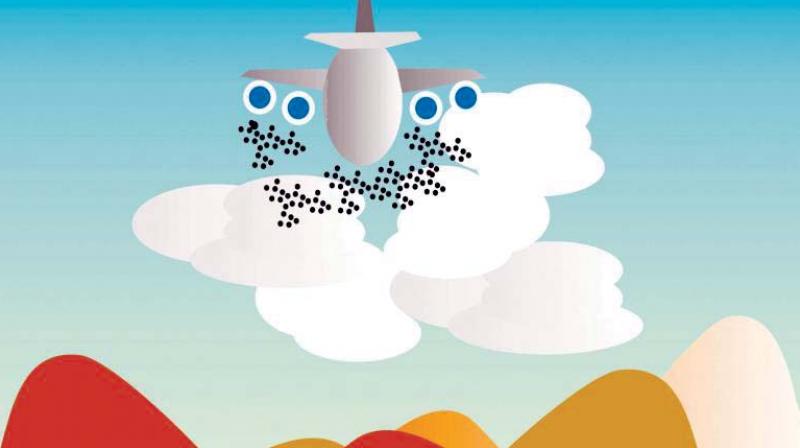Scientists thumbs up for Karnataka govt's cloud seeding

Bengaluru: The state government’s cloud seeding programme – ‘Varshadhari’ in 2017 has been touted as the best such initiative the world has seen so far by meteorologists and scientists, who were part of the initiative.
A recently submitted report by an independent evaluation committee comprising meteorologists and scientists from the internationally known research institutes – the Indian Institute of Tropical Meteorology (IITM), Indian Institute of Science (IISc), former director general of Meteorology, Indian Meteorological Department (IMD) Ajit Tyagi among others on June 18 has praised ‘Varshadhari’ and has called it the best cloud seeding exercise in the world till date.
The two-and-a-half month long exercise was conducted in Karnataka between August 21 and November 7, 2017 to seed the clouds in areas which was facing drought for the fourth consecutive year.
“So far Varshadhari remains the best cloud seeding initiative in the world in terms of its success rate, costing and the inclusion of the study of soil moisture. The exercise had increased the rainfall by 29 per cent and generated 2.1 tmc of additional water on the conservative side. For the first time the scientists and meteorologists had included soil moisture component, which was derived from satellite data products to identify most vulnerable areas. Priority was given to seed clouds in the region, where soil moisture was deficit. There was day-to-day monitoring of data, which was collected before and after the cloud seeding from the three Doppler radars that were installed in Bengaluru, Gadag and Raichur,” said Dr. J.R. Kulkarni, an eminent scientist at IITM, Pune. He was member of the monitoring and evaluation teams and has co-authored the evaluation report.
Former chief of State Disaster Management Committee and head of ‘Varshadhari’ monitoring committee Dr V.S. Prakash told Deccan Chronicle that the idea behind cloud seeding was to identify the vulnerable areas and mitigate drought distress, and the exercise was highly successful.
“The entire state of Karnataka was the field of operation, but the focus was the worst drought hit areas of North Karnataka – Gadag, Haveri, Dharwad, Vijayapura, Bagalkot, Belagavi, Raichur and Kalburagi, where soil moisture was highly deficit. We also concentrated on Bengaluru (rural), Mandya and Mysuru in South Karnataka,” Dr Prakash said.
He pointed out that the State has the highest density of rain gauges in the country. “The 600 rain gauges helped us evaluate the impact of cloud seeding. Rainfall was measured before and after the exercise and we had used specific scientific techniques to assess whether the rainfall was normal or due to cloud seeding. The monitoring and advisory committee used to monitor the impact on a daily basis,” Dr Prakash added.
The data that has been collected from the project will be of multiple uses to metereologists to study rain variability, Dr Kulkarni said. “The data from the three radars will help us understand cloud characteristics. The entire project will help us understand and improve upon the science of cloud seeding,” he added.
Dr V. Mudkavi, head of CSIR Fourth Paradigm Institute (formerly CSIR Centre for Mathematical Modeling and Computer Simulation), Prof. Manikyam (retired scientist from ISRO), chief engineer, rural water supply, H.S. Prakash Kumar were members of the monitoring committee. Prof Venugopal of IISc, Dr Kulkarni, Ajit Tyeagi, a retired DG, IMD; retired scientists from IITM, Dr S.B. Morwal and Dr. N.R. Deshpande were members of the evaluation committee.
The incumbent Chief Secretary Vijay Bhaskar was the then development commissioner and Principal Secretary, RDPR Dr. Nagambika Devi were very supportive of the programme. Cloud seeding was the brain child of the then RDPR Minister H.K. Patil.
Bengaluru-based Hoysala Projects Pvt. Ltd was awarded a Rs 30-crore contract for Varshadhari, which was taken up in three major catchment areas of Cauvery, Malaprabha and Tungabhadra rivers in the state.
Hoysala Projects had contracted US-based Weather Modification Inc to carry out the operations. The Central government had provided assistance in terms of required permission for the project.

